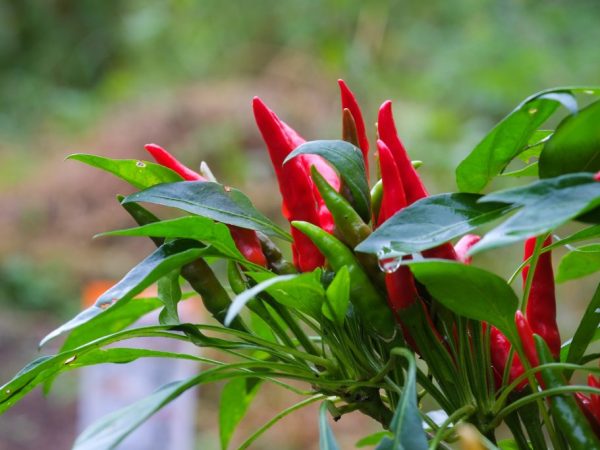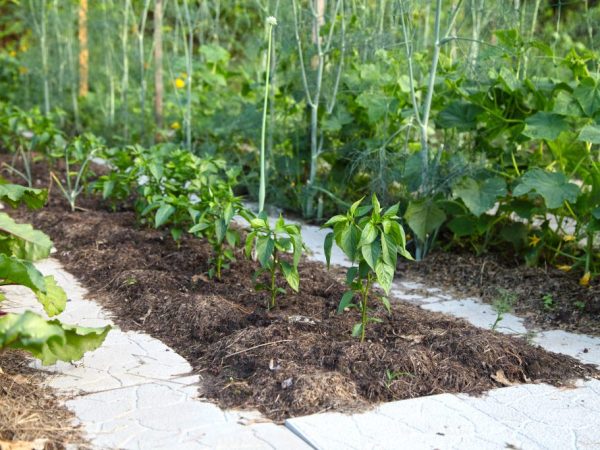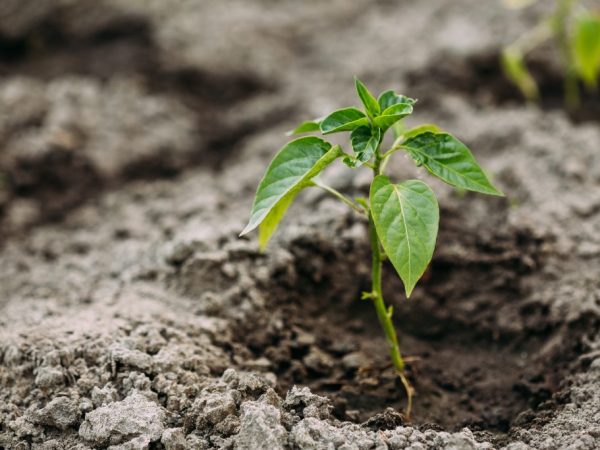Growing pepper in the open field
Sweet pepper is a favorite culture of many summer residents. It is appreciated for its excellent taste, useful properties (the content of vitamin C is higher than in black currant and lemon). Sweet and bitter (hot) varieties of peppers are distinguished by the content of a special alkaloid - capsaicin. Consider growing peppers outdoors.

Growing pepper in the open field
We plant seedlings
Bell pepper is a thermophilic culture that is demanding to care for. Let's figure out what secrets you need to know in order to provide optimal conditions for its growth and development.
Sowing seeds
Seed preparation options:
- seeds for 20 min. placed in a 1% solution of potassium permanganate, then soaked in water for 2-3 days;
- bubbling is carried out: the seed is kept in water saturated with oxygen (for example, using an aquarium compressor); 2 box of wood ash is added to the water, aloe juice can also be added (an excellent growth stimulant);
- the seeds are hardened: they are placed for 2 days in a refrigerator at a temperature of 2-5 ° C, then for a day at room temperature, after - for another 2 days they are kept in the cold and immediately sown.
The composition of the soil for seedlings is identical to the soil for growing tomatoes: a mixture of turf soil, humus and sand. Before sowing, the soil in the tray is watered with settled or melt water. Seeds are planted to a depth of 1 cm.The distance in a row is 2 cm, between rows - 3-4 cm.
The container is covered with glass or foil and left in a warm place for seeds to germinate. The optimum temperature is 25-27 ° С (at 15 ° С they may not rise at all).
Seedling care
The sprouts appear 6-10 days after sowing (the sparged seeds may sprout earlier). The root system of peppers is fibrous, located in the upper layer of the soil, therefore it is very sensitive to a lack of moisture. Watering should be frequent enough so that the ground does not dry out. At the same time, it is necessary to ensure that the water does not stagnate.
Seedlings love sunlight, but shade them in the middle of the day. On windows facing north, seedlings grow worse, so it is better to choose southern or western ones.
Before planting, the plants are fed twice with complex fertilizer. The first feeding is carried out after the appearance of 2 true leaves. You can feed the seedlings with fertilizers for home flowers (2 tsp for 5 liters of water).
Landing in open ground

Pepper grows well in warm weather
Growing bell peppers outdoors in warm climates gives excellent results. In southern latitudes, the necessary conditions can be created without shelter.
Site and soil preparation
The best place for pepper is a bed well-lit by the sun, sheltered from the wind. If there is no natural protection on the site (a nearby structure, dense bush), a wind protection structure is made on purpose.
When selecting a site, take into account that the best predecessors of the crop are cabbage, legumes, pumpkin plants, and root crops.It is not recommended to plant seedlings in beds where peppers or other nightshades were grown in the previous year.
The soil should be fertile, loose. It is prepared after the previous year's harvest. Be sure to remove plant residues and when digging for 1 sq. m make:
- rotted manure or humus (5-10 kg);
- wood ash (50-80 g);
- superphosphate (30-50 g).
Fresh manure cannot be used. An excess of nitrogen contributes to an excessive build-up of green mass, fragility of plants.
With spring loosening, you can replenish the reserves of phosphorus, potassium (30-40 g per 1 sq. M) and nitrogen (20-30 g per 1 sq. M).
Transplanting
7-10 days before the expected planting, the seedlings begin to harden. To do this, they take it out into the street (a place without drafts). First, leave for an hour, the time is gradually increased. This procedure helps to increase the immunity of plants to various diseases, provides faster adaptation to a new place.
The optimum soil temperature for planting peppers is 18 ° C and above. Usually this is mid-May (depending on the terrain and weather, the necessary conditions may develop a little earlier or later). At this point, 8-12 leaves should form on the bush (60-65 days). On the eve of transplanting, the seedlings are watered abundantly.
Bushes branch well, they need enough space for free development. The distance in a row should be 30-45 cm, between rows - 50-60 cm.You can plant seedlings in a square-nesting way: 60 x 60 cm - 2 plants per hole, 70 x 70 cm - 3.
The roots of the plant are located in the upper layer of the soil, and when the fruits ripen, the bush may not withstand the load and fall, therefore, when planting next to the plant, stick a peg more than half a meter high.
Care

Protect plants from disease
To grow a good harvest of pepper in the open field, you need to provide the culture with the correct agricultural technology.
Watering
The culture is very hygrophilous. Decreased leaves indicate a lack of moisture. This is a signal for immediate, abundant watering. The amount of water must be such that it penetrates at least 15 cm in depth.
The first watering should be done 5 days after planting the seedlings. Further - according to the state of the soil. The water should not be cold, otherwise the pepper will stop growing. A good effect is obtained by using magnetized water (using a special nozzle for a hose or an ordinary magnet in a watering can). Watering rules are traditional for nightshade crops: water at the root, without getting on the leaves, in the evening or morning hours.
Top dressing
During the growing season, sweet peppers are fed 2-3 times. The advantage is given to phosphorus-potassium fertilizers, less often nitrogen fertilizers are used. Top dressing can be root and foliar. Root and foliar are recommended to alternate. A good result is obtained by introducing chicken manure under the root.
Foliar dressing
By spraying the nutrients on the leaf, they are absorbed much faster. What foliar feeding can be done:
- with growth retardation - with urea (2 tsp for 5 liters of water);
- when shedding flowers - with boric acid (1 g per 1 liter of hot water, cool before use);
- with a weak filling of fruits - superphosphate (2% solution).
Gardeners also use organic matter. The cut grass, weeds are poured with water and infused for a week, stirring occasionally, then filtered and diluted with water in a ratio of 1:10.
It is correct to carry out such dressings in the evening hours or in cloudy calm weather, so that the nutrient moisture dries out more slowly and is better absorbed. The entire surface of the bush is sprayed, not excluding the lower part of the leaf plate, which absorbs much better.
Foliar dressing can be combined with treatment for diseases or pests. In this case, you need to strictly adhere to the dosage (usually it is higher than for applying under the root), because the tops can be burned.
Disadvantages of root feeding
- low soil temperature does not allow the roots to effectively assimilate the necessary substances);
- acidified, dense soils (nitrogen and other substances are very poorly absorbed);
- the need for additional nutrition when transplanting seedlings, rapid growth and abundant flowering.
Other recommendations
Caring for peppers in the open field involves observing several important rules:
- in order to protect the planting from temperature extremes at the beginning of summer, you can cover the pepper with a film stretched over wire arcs of a meter height; with early plantings, it is worth covering with a double layer of film;
- the crop's need for aerated soils makes it necessary to periodically loosen the beds; an alternative is mulching with straw, sawdust or planting bushes in a slot in a black film spread on the garden bed;
- to stimulate the formation of ovaries on hot summer days, the bush is slightly shaken so that self-pollination occurs (it is undesirable to manually transfer pollen from flower to flower, since this can damage the stigma and the ovary does not form);
- gardeners practice pinching the central stem and pinching the bushes to ensure good quality fruits ripen (leave 4-5 side shoots).
Sweet peppers are planted away from hot peppers. As a result of cross-pollination, the species qualities of each change.
Diseases and pests
Diseases
As a rule, bell peppers are less sick than other nightshades, such as tomatoes. The most common diseases are rot, wilting, bacteriosis. It is easier to prevent these diseases by observing crop rotation, destroying plant residues in the fall and dressing the soil before planting in the new season. In case of diseases, fungicides, biological products (trichodermin, phytosporin and others) are used.
Pests
The main crop pests are whiteflies, scoops, aphids, thrips.
In addition to insecticides, folk remedies are used to combat: an aqueous solution of wood ash (a glass on a bucket of water); chopped onions or garlic (200-250 g per bucket). The mixtures are insisted for at least a day, add soap for better adhesion. When growing sweet peppers in greenhouses, it is advisable to use biological remedies.
Conclusion
The cultivation of sweet peppers in the open field requires adherence to the rules of agricultural technology. To get a good harvest, you need to properly water, feed, pinch the bushes on time and collect fruits, and provide them with high-quality care.


